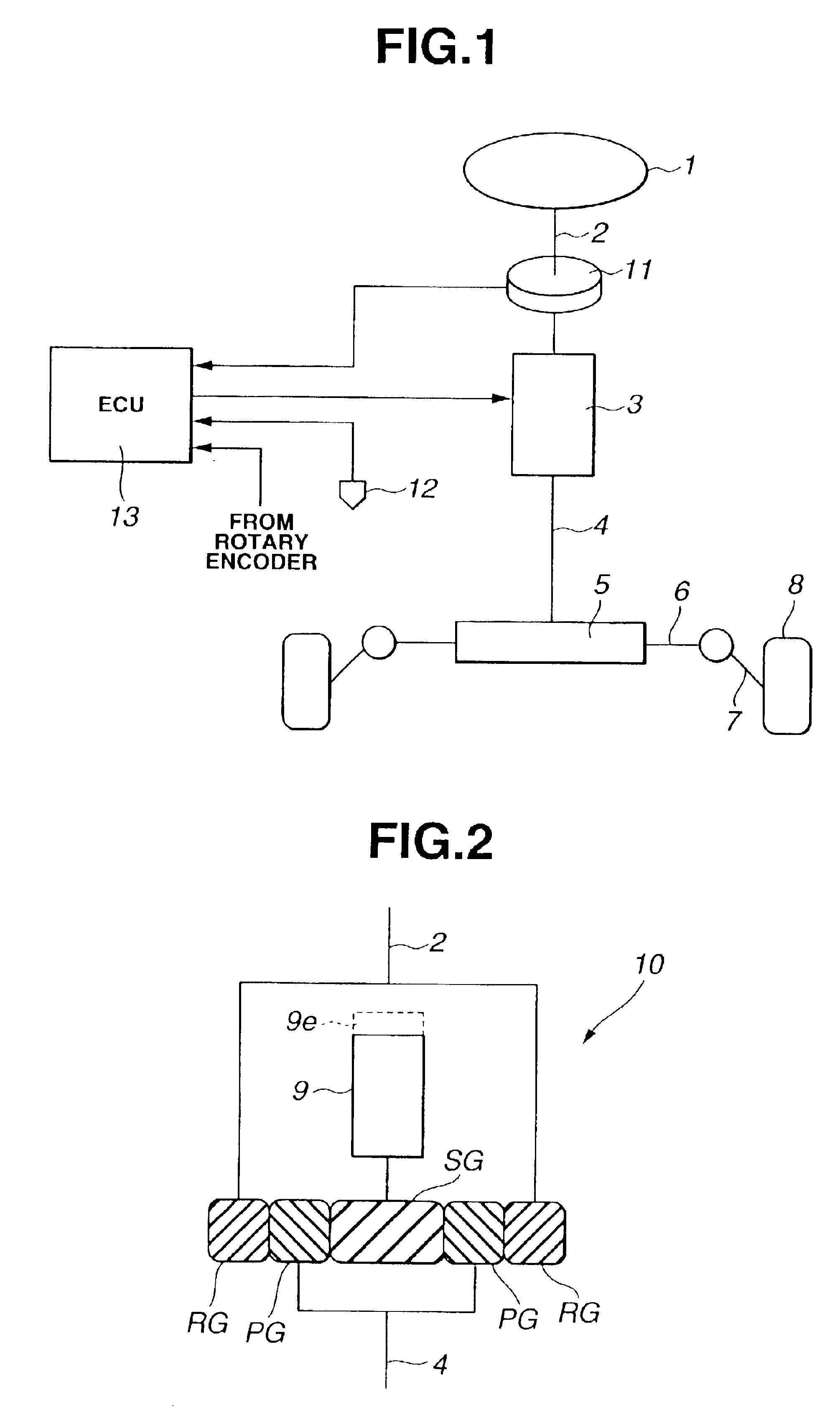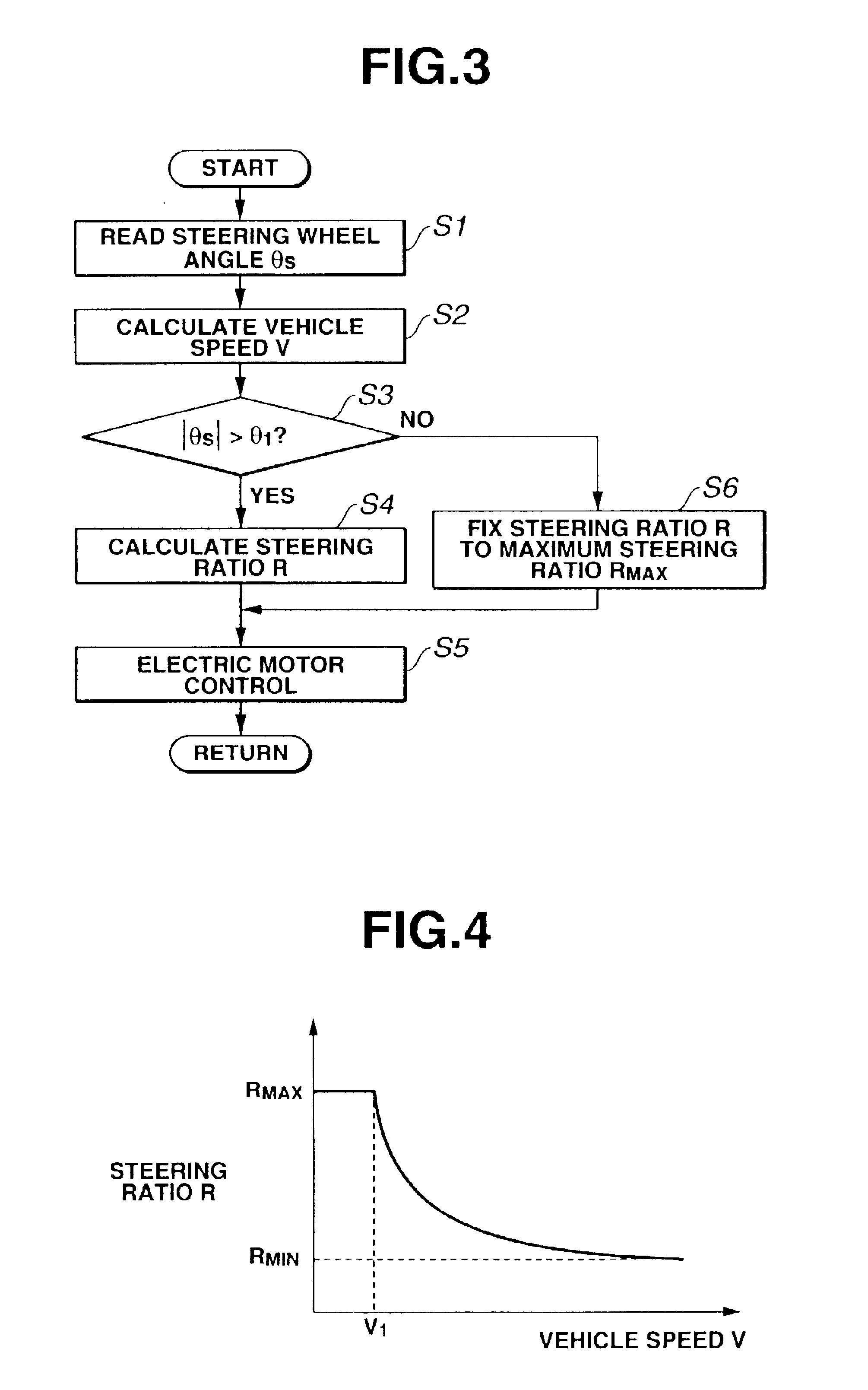Variable ratio steering system
a steering system and variable ratio technology, applied in the direction of steering initiation, instruments, vessel construction, etc., can solve the problems of increased tendency of unfavorable steering wheel offsetting, poor steering feel, and difficulty in permanent maintaining a proper relationship
- Summary
- Abstract
- Description
- Claims
- Application Information
AI Technical Summary
Benefits of technology
Problems solved by technology
Method used
Image
Examples
first embodiment
[0036]Hereinafter described in detail in reference to the flow chart shown in FIG. 3 is the variable steering ratio control routine executed by ECU 13 incorporated in the variable ratio steering system of the The arithmetic processing shown in FIG. 3 is executed as time-triggered interrupt routines to be triggered every predetermined sampling time intervals.
[0037]At step S1, steering wheel angle θS, which is detected by steering wheel angle sensor 11, is read.
[0038]At step S2, a vehicle speed V is calculated based on vehicle speed indicative signal VD from vehicle speed sensor 12.
[0039]At step S3, a check is made to determine whether an absolute value |θS| of steering wheel angle θS, read at step S1, exceeds a predetermined angle θ1. In the shown embodiment, predetermined angle θ1 is set to a predetermined low angle, such as 15 degrees or less, substantially corresponding to a neutral position (θS=0) of steering wheel 1. When the answer to step S3 is in the affirmative (YES), that ...
second embodiment
[0046]According to the system of the second embodiment shown in FIGS. 6 and 7, when the answer to step S3 is in the negative (NO), that is, in case of |θS|≦θ1, ECU 13 determines that the vehicle is maintained in a substantially straight-ahead driving state. In this case, the routine returns from step S3 to step S1, so as to bring variable steering ratio mechanism 3 into a non-control state. In the variable steering ratio control routine shown in FIG. 7, the processing of step S1 and steering wheel angle sensor 11 serve as a steering wheel angle detector (steering wheel angle detecting means) that monitors or detects steering wheel angle θS. The processing of step S2 and vehicle speed sensor 12 serve as a vehicle speed detector that monitors or detects vehicle speed V. The procedures of steps S3, S4, and S5 serve as a steering ratio control circuitry (steering ratio control means).
[0047]With the previously-discussed arrangement of the second embodiment, suppose that the vehicle is ma...
third embodiment
[0049]According to the system of the third embodiment shown in FIGS. 8 and 9, when the answer to step S3 is in the negative (NO), that is, in case of |θS|≦θ1, ECU 13 determines that the vehicle is maintained in a substantially straight-ahead driving state. In this case, the routine proceeds from step S3 to step S16. At step S16, in order to prevent or inhibit steering ratio R from fluctuating or changing depending on changes in vehicle speed V, steering ratio R is controlled or fixed to predetermined minimum steering ratio RMIN suited to the high speed range. In other words, in case of |θS|≦θ1, predetermined minimum steering ratio RMIN suited to the high speed range is held or determined as steering ratio R, until steering wheel angle θS exceeds predetermined angle θ1. Thereafter, the routine proceeds from step S16 to step S5. At step S5, first, steering ratio controlled variable C is calculated based on both a sign of steering wheel angle θS and predetermined minimum steering ratio...
PUM
 Login to View More
Login to View More Abstract
Description
Claims
Application Information
 Login to View More
Login to View More - R&D
- Intellectual Property
- Life Sciences
- Materials
- Tech Scout
- Unparalleled Data Quality
- Higher Quality Content
- 60% Fewer Hallucinations
Browse by: Latest US Patents, China's latest patents, Technical Efficacy Thesaurus, Application Domain, Technology Topic, Popular Technical Reports.
© 2025 PatSnap. All rights reserved.Legal|Privacy policy|Modern Slavery Act Transparency Statement|Sitemap|About US| Contact US: help@patsnap.com



